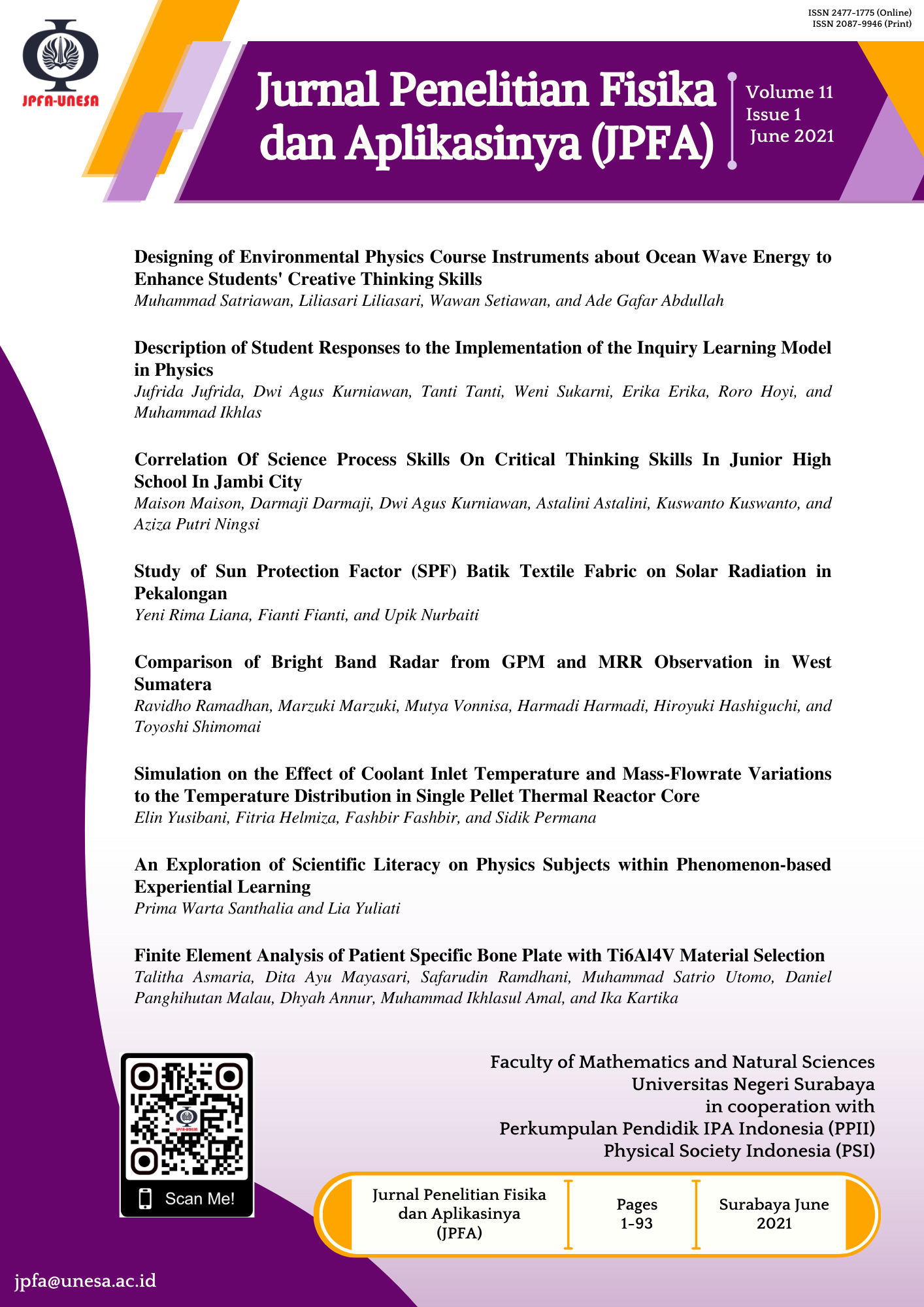Simulation on the Effect of Coolant Inlet Temperature and Mass-Flowrate Variations to the Temperature Distribution in Single Pellet Thermal Reactor Core
DOI:
https://doi.org/10.26740/jpfa.v11n1.p63-71Keywords:
Pellet, thermal rector, flowrate coolant, transient, temperature distributionAbstract
An important factor in the development of nuclear energy is reactor safety. The performance of heat transfer from nuclear fuel to coolant is the main key to the reactor safety. This paper presents simulation on temperature distribution in two-dimensional laminar flow for single pellet thermal reactor with variation on temperature inlet and mass-flowrate. The OpenFoam platform (SimFlow 3.1) has been used for the computational and numerical analysis. The simulation is carried out on a single pellet with an aspect ratio of 1.2. The variations in the mass velocity of the coolant flow are 10, 100, and 14300 kg×s-1 with a constant coolant temperature of 552 K, and the variations of the input coolant temperature are 300, 552, and 1000 K with a constant mass-flowrate of 10 kg×s-1. The results obtained from the simulation show that for variations in the input coolant temperature of 300, 552, and 1000 K, the fuel temperature can be reduced respectively by 34, 26, and 14 K. At the fastest variation in the coolant mass-flowrate of 14300 kg×s-1, the coolant temperature around the pellet rises by 396 K. The decrease in fuel temperature is significant if the mass-flowrate of the input coolant flow is relatively low.
References
Gen International Forum. GIF Annual Report; 2017. Available from: https://www.gen-4.org/gif/upload/docs/application/pdf/2018-09/gif_annual_report_2017_210918.pdf.
Huang S, Gong D, Li C, Guo X, Wang G, Yin H, and Wang K. Prediction of Flow and Temperature Distributions in a High Flux Research Reactor Using the Porous Media Approach. Science and Technology of Nuclear Installations. 2017; 2017: 7152730. DOI: https://doi.org/10.1155/2017/7152730.
Juarsa M, Purba JH, Kusuma HM, Setiadipura T, and Widodo S. Preliminary Study on Mass Flow Rate in Passive Cooling Experimental Simulation During Transient Using NC-Queen Apparatus. Atom Indonesia. 2014; 40(3): 141-147. DOI: https://doi.org/10.17146/aij.2014.333.
Zvirin Y. A Review of Natural Circulation Loops in Pressurized Water Reactors and Other Systems. Nuclear Engineering and Design. 1982; 67(2): 203-225. DOI: https://doi.org/10.1016/0029-5493(82)90142-X.
Abdillah H, Saputra G, Novitrian, and Permana S. Study of Natural Convection Passive Cooling System for Nuclear Reactors. Journal of Physics: Conference Series. 2017; 877: 012047. DOI: http://dx.doi.org/10.1088/1742-6596/877/1/012047.
Murata H, Sawada K, and Kobayashi M. Experimental Investigation of Natural Convection in a Core of a Marine Reactor in Rolling Motion. Journal of Nuclear Science and Technology. 2000; 37(6): 509-517. DOI: https://doi.org/10.1080/18811248.2000.9714924.
Zitek P and Valenta V. Solution of heat Removal from Nuclear Reactors by Natural Convection. The European Physical Journal Conferences. 2014; 67: 02133. DOI: http://dx.doi.org/10.1051/epjconf/20146702133.
Septiawan RR, Abdillah H, Novitrian and Suprijadi. Preliminary Study on Liquid Natural Convection by Temperature Differences. Proceedings of The 2014 International Conference on Advances in Education Technology. 2014; 1984(1): 140-143. DOI: http://dx.doi.org/10.1063/1.5046591.
Zitek P and Valenta V. Solution of Heat Removal from Nuclear Reactors by Natural Convection. European Physical Journal Web of Conferences. 2014; 67: 02133. DOI: http://dx.doi.org/10.1051/epjconf/20146702133.
Wang J, Deng M, Wang D, Zhang S, Qiu GH, and Su W. Tian, Numerical Simulation of Temperature Heterogeneity Inside The AP1000 Upper Plenum and Hot Leg. Nuclear Engineering and Design. 2020; 362: 110525. DOI: http://dx.doi.org/10.1016/j.nucengdes.2020.110525.
Zavattoni SA, Barbato MC, Pedretti A, and Zanganeh G. CFD Simulations of a Pebble Bed Thermal Energy Storage System Accounting for Porosity Variations Effects. SolarPaces 2011 Conference. 2011; 24636. Available from: https://www.researchgate.net/publication/250946250.
Koloszar L, Planquart P, Tichelen, and Keijers S. Simulation of Loss of Flow Transient in The MYRRHA Reactor. Nuclear Engineering and Design. 2020; 363: 110675. DOI: https://doi.org/10.1016/j.nucengdes.2020.110675.
Wang M, Wang L, Wang X, Ge J, Tian W, Qiu S, and Su GH. CFD Simulation On The Flow Characteristics in The PWR Lower Plenum with Different Internal Structures. Nuclear Engineering and Design. 2020; 364(1): 110705. DOI: https://doi.org/10.1016/j.nucengdes.2020.110705.
Lodh BK, Das AK, and Singh N. Large Eddy Simulation Turbulence Modeling for wind Flow over Wall Mounted Cube. International Journal of Chemical Engineering Research. 2017; 9(1): 7-39. Available from: https://www.ripublication.com/ijcher17/ijcherv9n1_02.pdf.
Murugesan MP and Balasubramanian R. The Effect of Mass Flow Rate on the Enhanced Heat Transfer Characteristics in A Corrugated Plate Type Heat Exchanger. Research Journal of Engineering Sciences. 2012; 1(6): 22-26. Available from: http://www.isca.me/IJES/Archive/v1/i6/4.ISCA-RJEngS-2012-097.pdf.
Adi AR and Arsana IM. Analisa Pengaruh Laju Aliran Massa Fluida dan Temperatur Fluida Masuk Terhadap Kapasitas Radiator pada Sistem Pendingin Daihatsu Xenia 1300 cc. Jurnal Pendidikan Teknik Mesin. 2018; 6 (3): 1-9.
Wang Y, Li J, Ning X, Zhong Q, Miao J,Wang L, Lyu W, and Liu C. Influences of Mass Flow Rate on Heat and Mass transfer Performances of Water Sublimator combined with Fluid Loop. Chinese Journal of Aeronautics. 2019; 32(4): 888-894. DOI: http://dx.doi.org/10.1016/j.cja.2019.01.010.
Welty J, Wicks CE, Rorrer GL, and Wilson RE. Fundamentals of Momentum, Heat and Mass Transfer. US: John Wiley and Sons, Inc; 2007.
AP1000 European Design Control Document, EPS-GW-GL-700 Revision 1: Westinghouse. Available from: http://www.ukap1000application.com/doc_pdf_library.aspx [accessed 8 March 2019].
Downloads
Published
How to Cite
Issue
Section
License
Copyright (c) 2021 Jurnal Penelitian Fisika dan Aplikasinya (JPFA)

This work is licensed under a Creative Commons Attribution-NonCommercial 4.0 International License.
Author(s) who wish to publish with this journal should agree to the following terms:
- Author(s) retain copyright and grant the journal right of first publication with the work simultaneously licensed under a Creative Commons Attribution-Non Commercial 4.0 License (CC BY-NC) that allows others to share the work with an acknowledgement of the work's authorship and initial publication in this journal for noncommercial purposes.
- Author(s) are able to enter into separate, additional contractual arrangements for the non-exclusive distribution of the journal's published version of the work (e.g., post it to an institutional repository or publish it in a book), with an acknowledgement of its initial publication in this journal.
The publisher publish and distribute the Article with the copyright notice to the JPFA with the article license CC-BY-NC 4.0.
 Abstract views: 551
,
Abstract views: 551
, PDF Downloads: 0
,
PDF Downloads: 0
, PDF Downloads: 438
,
PDF Downloads: 438
, PDF Downloads: 0
,
PDF Downloads: 0
, PDF Downloads: 0
PDF Downloads: 0









